
What it takes to execute large-scale and lasting transformations Successfully executing a complex, enterprisewide program that quickly delivers results may be the most elusive element of digital industrial transformation
12 minute read
23 November 2020
To create value, a digital transformation demands an upfront, top-down commitment to rigor, transparency, and accountability. The solution: a transformation nerve center. This article, 14th in a series on digital industrial transformation, aims to help leaders keep execution on track.
Introduction
Throughout our series on digital industrial transformation,1 we have discussed specific steps that leaders should take to drive change within businesses and operations to enhance competitiveness: laying out a clear business and technology strategy,2 defining new business models,3 refreshing the enterprise operating model,4 and implementing a digital, customer-centric technology stack.5 While each of these changes demands coordination even in isolation, a comprehensive digital transformation requires that leaders commit to a simultaneous series of interdependent cross-functional changes.
Learn more
Explore the Digital industrial transformation collection
Learn about Deloitte's services
Go straight to smart. Get the Deloitte Insights app
And that commitment carries risk: The breadth and complexity of change and novelty of digital transformation can quickly destroy value rather than create it. Most often, this value destruction manifests as false starts, miscommunication, frequent changes in direction, or transformation fatigue—all of which lead to tangible losses in capital, talent, and investor confidence.6 In our experience, the most effective way to implement the change to which executives aspire is through the implementation of a transformation management office to drive an upfront, top-down commitment to transformation rigor, funding, transparency, and accountability.
However, we often see such offices operate similarly to a traditional project management office, with responsibilities limited to tracking and reporting, risk management, and communications. For transformations to take hold, and for their effects to be sticky and sustainable, an office needs to address the inherent complexities of a transformation, including defining the transformation ambition, scoping and planning, managing the transformation budget, and actively managing multiple workstreams and stakeholders. Indeed, the most successful transformation management offices are those that comprise both executors (operators) and tacticians (strategists) to serve as the transformation’s true control tower. We refer to these high-performing offices as transformation nerve centers, or TNCs.
A TNC is chartered with comprehensively managing the planning, execution, and the outcomes of digital industrial transformation. The sheer complexity, scope, and ambiguity of transformation require dedicated capabilities to architect the transformation, orchestrate across multiple intersecting threads of work, and track progress against goals.
While there are some overlaps in responsibility and positioning, a TNC has a substantially larger scope than a typical transformation management office or program management office. A TNC tracks and reports on progress, identifies and prioritizes potential risks, and manages the transformation budget. But it also sets the transformation agenda, drives communications with stakeholders, dynamically launches and winds down specific efforts, ensures tight coordination among workstreams, and, most critically, makes the critical decisions needed to drive the program forward.
In this article, we discuss the role of the TNC, the components of a high-performing center, and how the TNC’s role might change based on a transformation’s phase or type. However, we do not prescribe a center’s inner workings—governance and decision rights, communication frequency and audiences, organization structure, and engagement model with other business functions and workstreams—all of which should be designed to align with the organization’s transformation and culture. Leaders should look to establish these ways of working early to help ensure consistency and build credibility.
The case for a TNC
Poll 100 executives, and you will likely get as many answers for what transformation means. Many consider an organizationwide technology change a transformation; others might argue that any change in current processes or headcount rationalization constitutes a transformation. And indeed, these may feel transformative. But we don’t see the need for a true TNC outside of end-to-end digital industrial transformation; for many programs with a more focused scope—for instance, a technology implementation or new process rollout—a more traditional project management office will suffice and be more efficient and cost-effective.
Comprehensive digital industrial transformation, however, requires the implementation of strong and dedicated TNC capabilities. Such a transformation typically has five characteristics: It is enterprisewide and affects every aspect of the organization; it drives a step-change in the enterprise operating model or stands up new business models; it must be led by the executive team and not by only line managers; it must be multifunctional; and it aims to deliver meaningful change to the enterprise’s financial position.
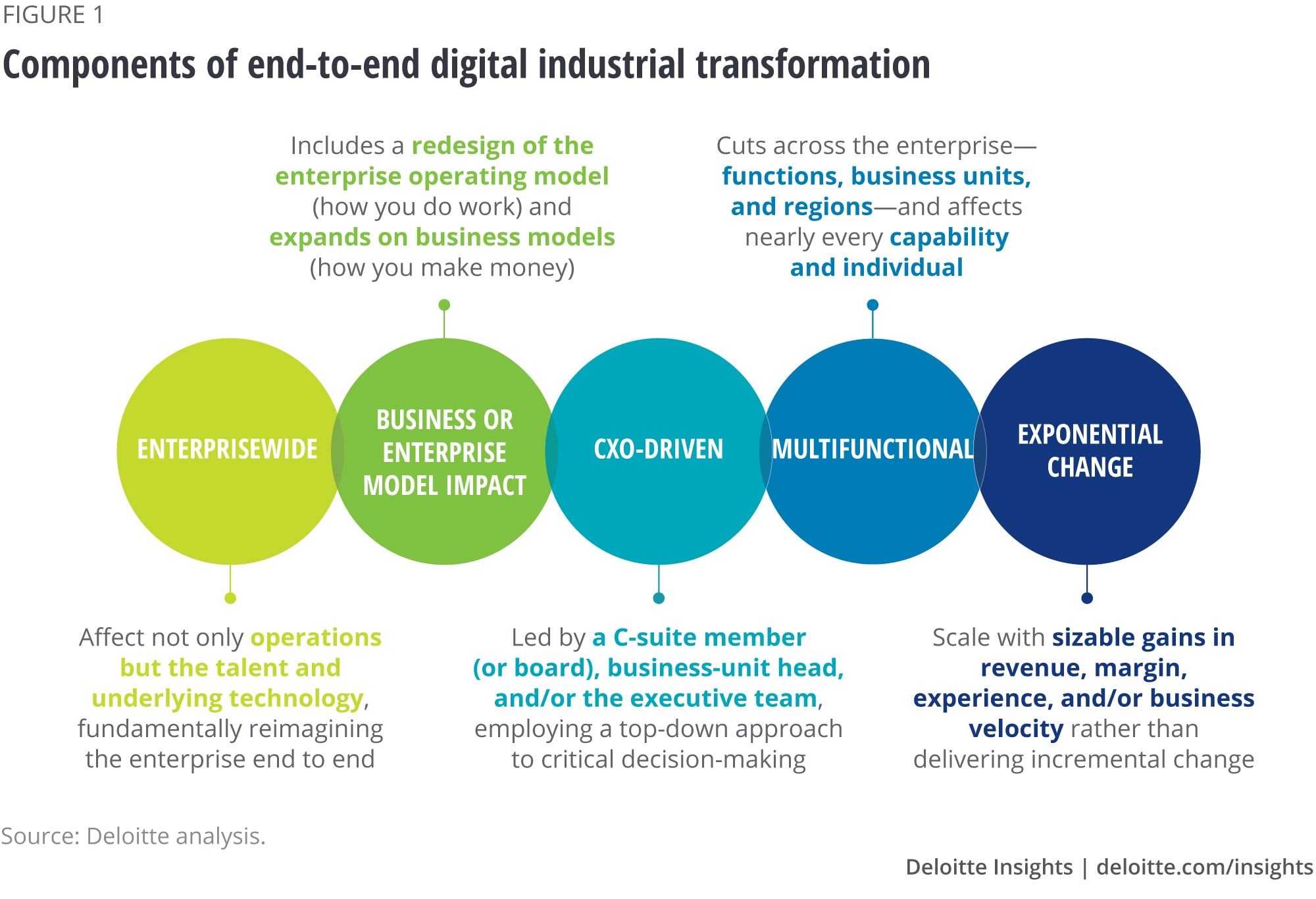
These digital industrial transformations typically require a meaningful share of CXO bandwidth, affect almost every stakeholder, demand clear, coordinated, and consistent messaging, and, most importantly, require rapid, deliberate—and often tricky—decision-making. No single business function is equipped to handle the scope and velocity of managing the scope of such a transformation: It requires capabilities that are often spread across functions, including strategy, risk, change management, external and internal communications, finance, and technology, in addition to the traditional front-office functions—sales, services, marketing, product—that typically undergo the most significant transformation. Most corporate structures distribute capabilities and accountability across the company, straining decision-making, coordination, and communication.
A TNC will house capabilities most critical to the transformation under unified leadership with broader decision rights and a singular focus on architecting, orchestrating, and governing the transformation. Moreover, leaders can design a center to overcome some of the most common reasons transformations fail, including employee resistance, inadequate sponsorship, and poor project management.7
As with any extensive, enterprisewide program, a digital industrial transformation has a multitude of workstreams: distinct but interdependent efforts with specific goals, performance metrics, leadership, and scope. A TNC typically includes representation from three stakeholder groups: business unit leaders—executives who own development, manufacture, sale, and service of offerings, who are deeply technical, and closely support revenue generation; functional—leaders that serve in a supporting role, are often cost centers, and support all business units equally; and cross-functional—leaders that are appointed specifically for the duration of the transformation and are tasked with driving transformation effectiveness, transparency, and “stickiness.” Finally, note the presence of the digital function, which is new to most organizations, and which we will explore in greater detail in a forthcoming article. Figure 2 illustrates a sample TNC structure: No matter the nature or number of workstreams, the center should sit above and alongside the workstreams.
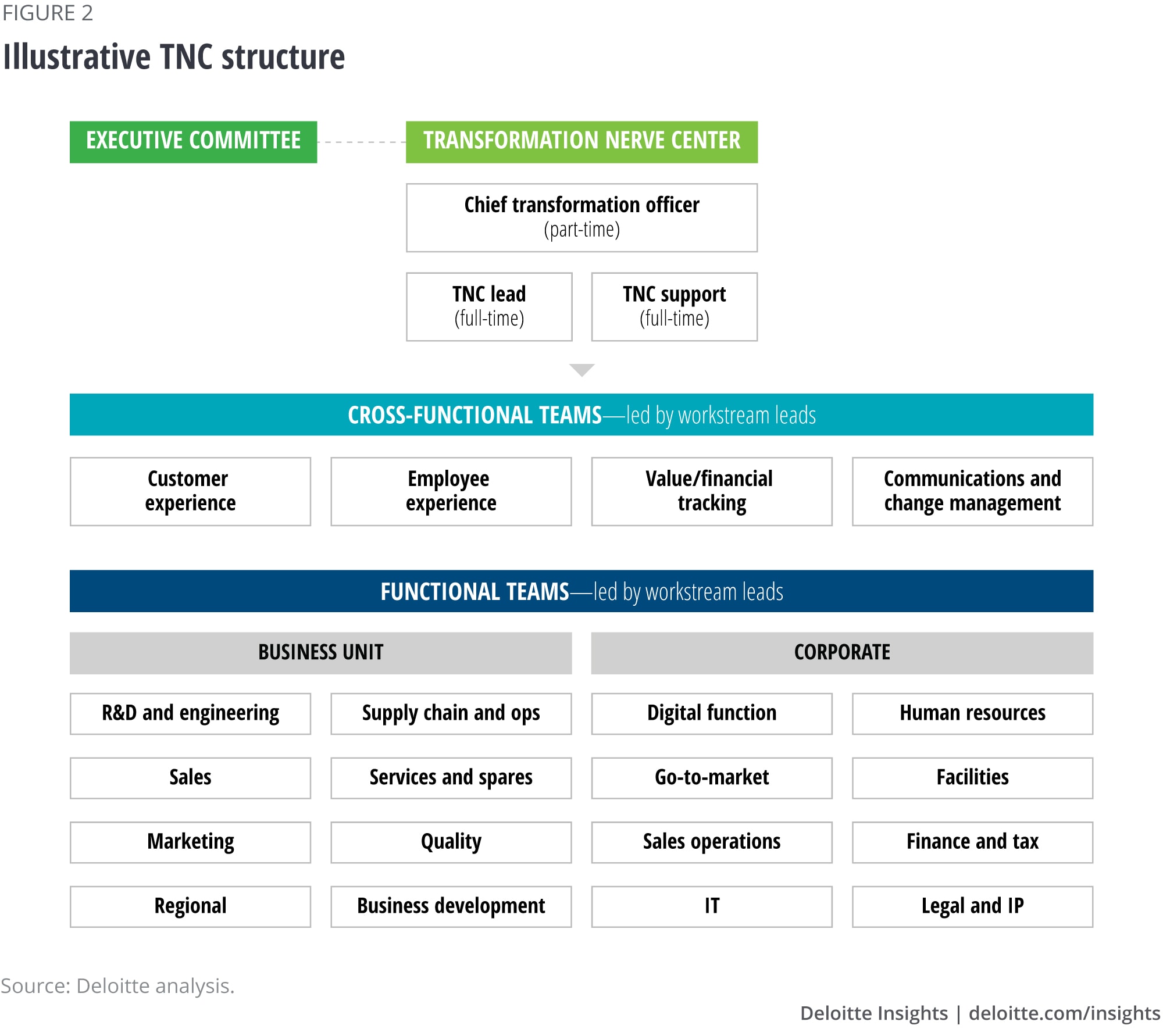
Of course, TNC workstreams can be scoped differently, based on the nature of the transformation. For example, workstreams can also be scoped by business outcome (for example, deliver a smoother digital buying process) or geography.
The TNC’s role during a transformation
A TNC delivers a broad set of outcomes. These can be grouped into three major categories: architect the transformation, orchestrate the transformation, and track the transformation. As mentioned, a TNC does many things that a traditional transformation management office would do (highlighted in figure 3), especially in the track category. However, a TNC goes materially beyond the scope of such an office by taking on additional architect and orchestrate responsibilities. Again, this requires a cross-functional set of leaders—a combination of strategists and executors.
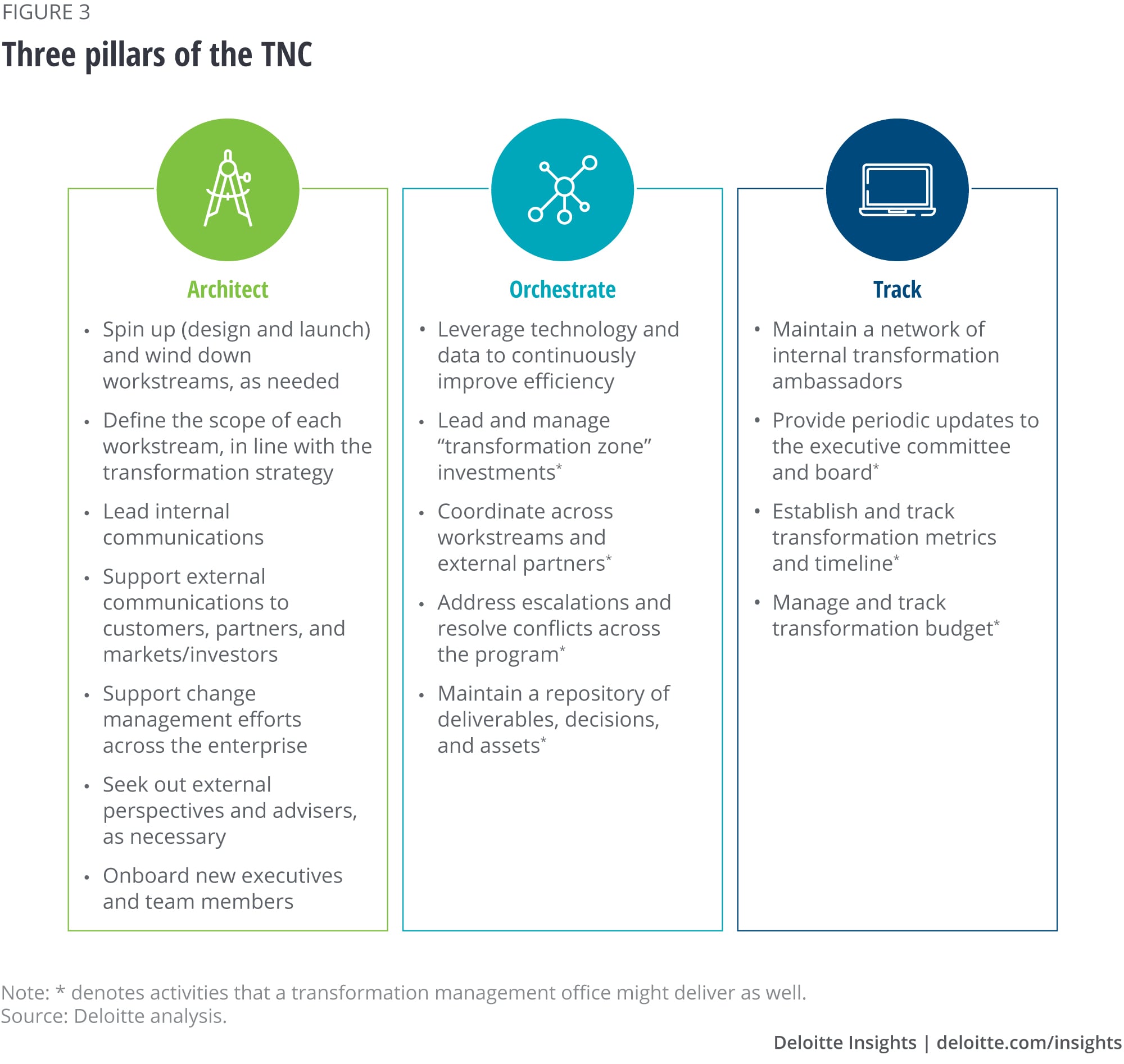
The TNC will allocate time differently across a transformation program, based on the stage. During the early stages, the center will over-index on architecting the transformation, ensuring that overall objectives are set and communicated, leaders identified, workstreams scoped, and ways of working established. As the transformation effort gains momentum8—including through new product launches,9 cocreative10 and go-to-market partnerships,11 and the development of an ecosystem12—orchestration and governance become more critical to ensure open lines of communication across workstreams, transparency among all stakeholders, and an open knowledge base of facts and learning makes the transformation increasingly effective. During the back half of the transformation, reporting, communication, and knowledge management become critical to sustaining the program. Indeed, breaking through transformation fatigue is a vital role of the TNC at this stage, as new priorities invariably emerge, and executives get distracted. As such, an emphasis on internal communications (to continually socialize the transformation’s value) and external communications (to keep customers, partners, and investors abreast of forthcoming changes) is fundamental to the center’s role.
However, throughout the transformation, the TNC should consistently emphasize agile execution and decision-making—dynamic, real-time, and data-driven. Center leaders should challenge executives and workstream leaders to consider the organization’s growth aspirations and to take on calculated risks while looking forward. The TNC should also actively facilitate discussions on trade-offs—financial, operational, or strategic—and the risk of inaction with business leaders who struggle to embrace the transformation. As such, a center can both shape the transformation and coach the business in parallel. Indeed, the level, tenure, and skill set of the individuals that comprise the TNC is critical. Our annual Human Capital Trends report explores these topics in greater detail.13
Characteristics of high-performing transformation teams
Once the goals of the transformation—how wide, how fast, how different—have been established and communicated, the most critical element of executing successful transformations is the team itself, beginning with the TNC. As with most individuals, the most effective centers are a combination of art and science—or nature and nurture. Teams should aim to include individuals with demonstrated leadership capabilities, excellent program management capabilities, experience navigating the organization, and an ability to deal with complexity, seniority, and bandwidth (science); they should be able to innovative, invoke trust, and stay dedicated to the transformation’s goals (art). Our experience shaping and supporting end-to-end transformations has helped uncover, specifically, seven characteristics that characterize high-performing TNCs (figure 4).
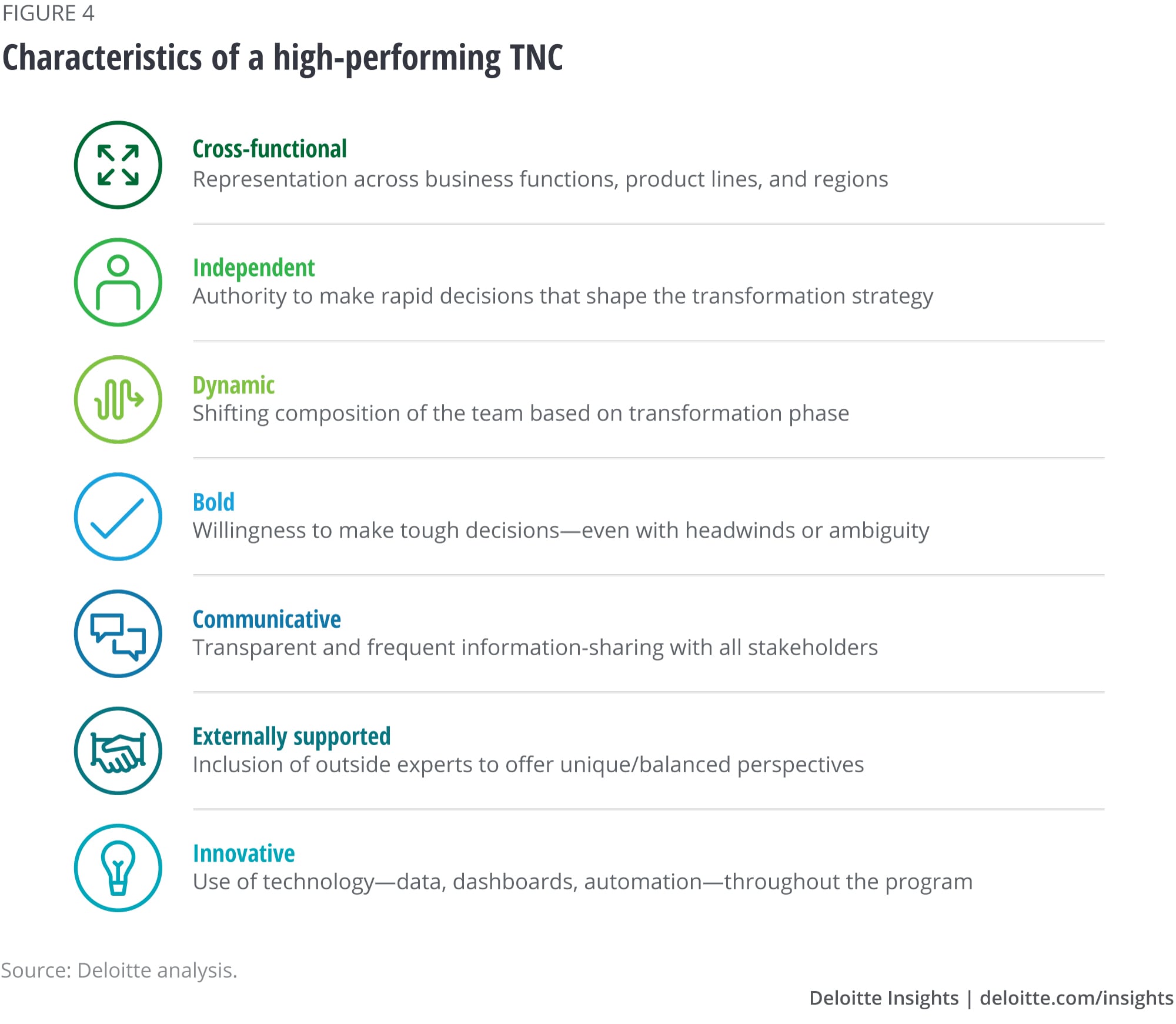
While there are several other elements fundamental to transformation success—we’ve discussed these in detail in earlier installments in this series—an aspect unique to the TNC is transformation scoping. Biting off more than the organization can chew creates the feeling of an impossible task, but too small a scope doesn’t feel like a transformation at all and risks the program losing attention, impact, and focus. We’ve seen repeated success with dynamic scoping, in which the TNC takes charge of setting goals for shorter periods or agile execution sprints of eight to 12 weeks. The plans reflect organizational priorities at the time and allow the TNC to adjust every few months.
For example, rather than committing resources and capital to the end-to-end transformation of the sales function over two years, the TNC might break this up into six to eight efforts, each focused on a separate but critical component of the sales transformation—sales strategy, partner and channel strategy, territory planning, compensation, sales operations, and so on. In this way, the TNC provides line of sight into the overall goals but makes each element more achievable. Also, dynamic scoping forces the organization to build momentum and continually deliver results, drives accountability, and, most critically, allows resources to be reallocated. If, say, sales operations or marketing changes are more critical, given recent customer feedback, those “sprints” of work can be accelerated.
However, dynamic scoping doesn’t mean that principles of the transformation are up for negotiation every few weeks. The transformation North Star and blueprint—the ambition, timeline, core business models, enterprise operating model, and technology architecture—must continue to guide the tactical decisions around scope, resource allocation, budgeting, and milestone planning. This minimum viable product approach to scoping still leads to tangible outcomes but provides the program the flexibility it needs to change priorities if necessary. Indeed, dynamic scoping requires a strong leader that embraces the transformation strategy, has a deep understanding of the market, and can shape and influence the direction of the program—particularly amid potential naysayers and given the involvement of senior stakeholders such as the CEO and board.
To chief transformation officer or not?
The role of a chief transformation officer (CTrO) is one that is hotly debated among companies and consultancies undertaking and advising on digital industrial transformation. We see the need for accountable and effective leadership to helm a transformation but believe that whether that leader has the CTrO title is less crucial. The role often comes with baggage, carrying a sense of: expectation, given the scope and disruptive nature of digital industrial transformation; finality, since every transformation should have an endpoint; and conflict, because a CTrO’s scope and decision rights might interfere with those of other executives. At the same time, the appointment of a CTrO can send positive market signals, help ensure that transformation doesn’t overwhelm other executives, and allow the cultivation of transformation-specific skill sets.
In our experience advising large corporations, we have seen that successful transformation leaders have five essential qualities:
- Bandwidth to fully commit to the demands of a digital industrial transformation
- Deep understanding of the company’s customers, markets, and operations
- Risk appetite to take on challenges and stick to the goals of the transformation
- Authority to make transformation-related decisions in partnership with the CEO
- Influence with other executives so that decisions are implemented effectively
As such, the most effective transformation leaders—CTrOs, if companies so choose—are forward-thinking industry insiders who command the respect of their peers and the broader organization and have the authority to shape the transformation’s path. This type of executive is not easy to find or retain, and CEOs and boards should identify the right leader before launching a large-scale transformation.
Designating a CTrO
We recently collaborated with a large global technology company to do two things in parallel: mature existing offerings using new business models and stand up a new line of business that would require differentiated capabilities, sales motions, and partnerships. Given the transformation’s scope and criticality, the client dedicated a member of the executive team as the CTrO and relieved him of other day-to-day responsibilities, demonstrating strong commitment to the program.
In addition, the TNC included a handpicked set of high-performing individuals from finance, product, communications, and sales. The two-year transformation, which was self-funded through targeted cost reductions, included more than 50 workstreams—no more than seven at a time—delivered in a dynamic way (figure 5) and spanned front-office and back-office capabilities. As a result, our client enabled US$1 billion in expected revenue over five years, made more than 30 strategic executive hires, launched three new products, and closed two strategic acquisitions.
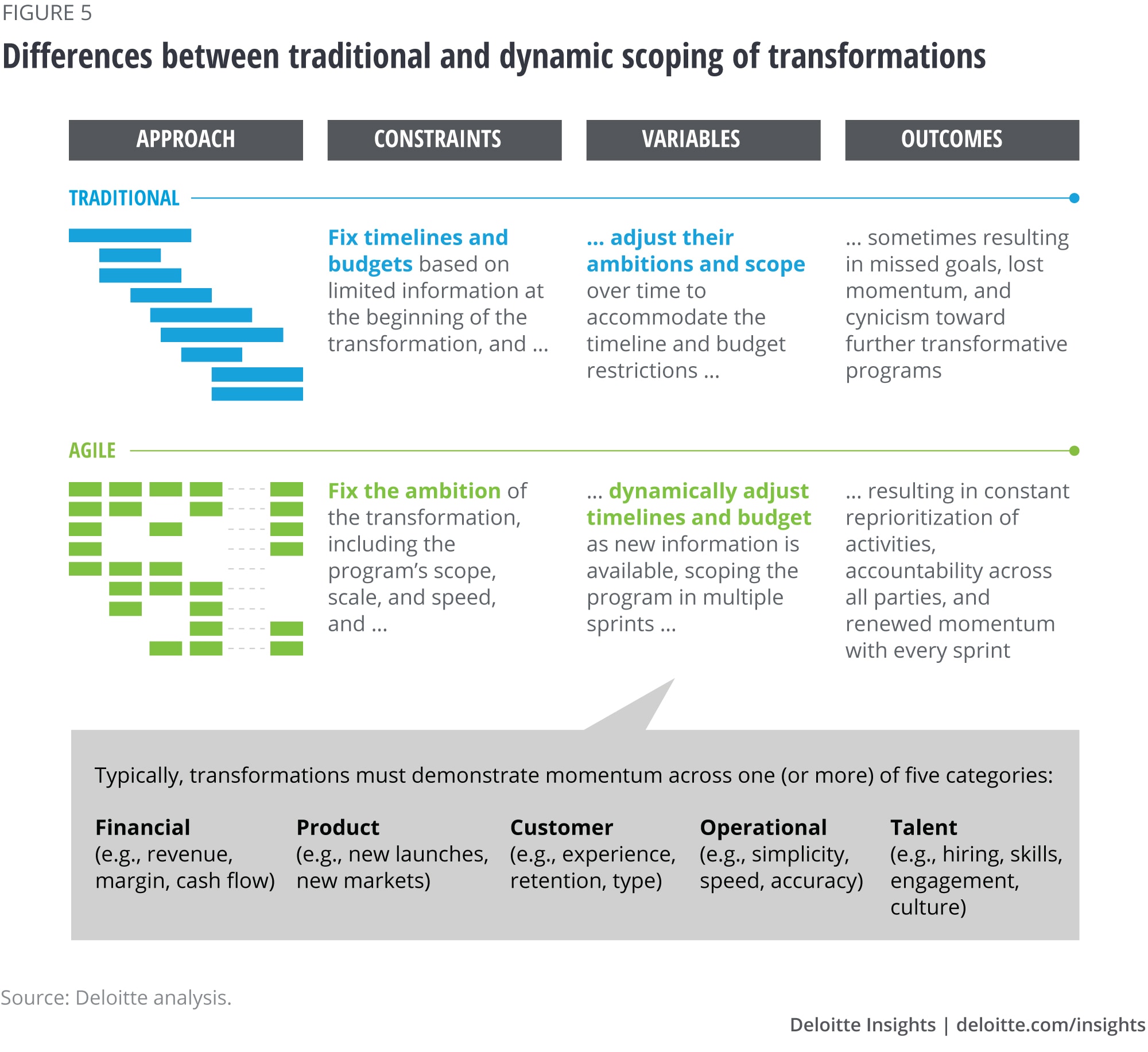
Closing thoughts
True transformations are inherently challenging to manage—they often come with high expectations, tight timelines, and a wealth of skepticism among stakeholders. Yet when executed to plan, a digital industrial transformation can recast the fortunes of a struggling business, attract new customers and talent, help unlock innovation across the enterprise, encourage a culture of experimentation, and build lasting operational efficiency.
A transformation nerve center can be a critical piece of the transformation program. The TNC creates visibility, intensity, and accountability, cornerstones of successful transformations. As more and more enterprises face the need to change—because of new competitors, business model disruption, technological change, or increased customer expectations—decisive reinvention of business and operating models is becoming increasingly critical to value creation, and digital industrial transformation will be central to achieving these goals. A strong TNC can be instrumental in architecting, orchestrating, and tracking the transformation journey, and helping companies achieve their transformation ambitions and outcompete the market.
Explore the digital transformation collection
-
Digital platform as a growth lever Article4 years ago
-
How cocreation is helping accelerate product and service innovation Article5 years ago
-
Ecosystem-driven portfolio strategy Article5 years ago
-
Radically transforming your support models Article5 years ago
-
Redesigning partner experience in Industry 4.0 Article4 years ago
-
Scaling up anything as-a-service Article5 years ago
















